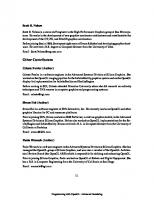100+ Advanced VB.NET Examples: A Beginner's Guide to Mastering Advanced Programming Techniques
Unlock the full potential of VB.NET with this comprehensive eBook! Dive into the world of Visual Basic programming and e
151 61 836KB
English Pages 501 Year 2023
Table of contents :
VB.Net Environment Setup: A Comprehensive Guide
Table of Contents
1. Introduction to VB.NET
2. System Requirements
3. Installing Visual Studio
Step 1: Download Visual Studio
Step 2: Run the Installer
Step 3: Install Visual Studio
4. Creating a New VB.NET Project
Step 1: Open Visual Studio
Step 2: Create a New Project
5. Understanding the Visual Studio Interface
6. Configuring Visual Studio for VB.NET Development
7. Writing Your First VB.NET Program
Step 1: Open the Code Editor
Step 2: Write the Code
Step 3: Run the Program
8. Conclusion
VB.NET Program Structure: Understanding the Basics
Table of Contents
1. Introduction to VB.NET Program Structure
2. Components of a VB.NET Program
- Module
- Declarations Section
- Main Procedure
- Procedures and Functions
- Control Structures
- Error Handling
3. Declarations and Comments
Declarations
Comments
4. Data Types and Variables
Data Types
Variables
5. Control Structures
If-ElseIf-Else
For Loop
Select Case
6. Procedures and Functions
Sub Procedures
Functions
7. Error Handling
Try-Catch-Finally
8. Conclusion
Understanding the basic syntax of Visual Basic .NET
Table of Contents
1. Introduction to VB.NET Basic Syntax
2. Statements and Comments
Statements
Comments
3. Variables and Data Types
Variables
Data Types
4. Operators
Arithmetic Operators
Comparison Operators
Logical Operators
5. Control Structures
If-ElseIf-Else
For Loop
Select Case
6. Procedures and Functions
Sub Procedures
Functions
7. Exception Handling
Try-Catch-Finally
8. Conclusion
Understanding data types
Table of Contents
1. Introduction to Data Types in VB.NET
2. Built-in Data Types
Integer Types
Floating-Point Types
Decimal Type
Textual Types
Boolean Type
Date and Time Types
3. Value Types vs. Reference Types
Value Types
Reference Types
4. Type Conversion and Casting
Implicit Conversion
Explicit Conversion (Casting)
5. Arrays and Collections
Arrays
Collections
6. Nullable Types
7. Conclusion
Understanding variables in Visual Basic .NET (VB.NET) is crucial as they serve as containers for storing and manipulating data within a program. This comprehensive guide will cover the fundamentals of variables in VB.NET, providing explanations, examples, and practical insights into their usage.
Table of Contents
1. Introduction to Variables in VB.NET
2. Declaring Variables
Syntax:
Example:
3. Variable Naming Conventions
Naming Rules:
Example:
4. Assigning Values to Variables
Example:
5. Variable Scope
Local Variables
Module-Level Variables
Global Variables
Example:
6. Constants
Example:
7. Variable Data Types
Example:
8. Type Inference
Example:
9. Variable Lifetime
10. Conclusion
understanding constants and enumerations in Visual Basic .NET (VB.NET) is crucial as they allow developers to define fixed values and create named constant sets. This comprehensive guide will cover the concepts of constants and enumerations in VB.NET, providing explanations, examples, and practical insights into their usage.
Table of Contents
1. Introduction to Constants in VB.NET
2. Declaring Constants
Syntax:
Example:
3. Advantages of Using Constants
4. Examples of Constants
Mathematical Constants
Application Constants
Error Codes
5. Introduction to Enumerations in VB.NET
6. Declaring Enumerations
Syntax:
Example:
7. Enumerations with Assigned Values
Example:
8. Enumerations with Flags Attribute
Example:
9. Examples of Enumerations
Days of the Week
Months of the Year
File Permissions
10. Conclusion
modifiers are keywords that are used to modify the declaration of classes, methods, properties, fields, and other members to specify different access levels, behaviors, or characteristics. This comprehensive guide will cover the various modifiers available in VB.NET, providing explanations, examples, and practical insights into their usage.
Table of Contents
1. Introduction to Modifiers in VB.NET
2. Access Modifiers
Public
Protected
Private
Friend
Protected Friend
3. Non-Access Modifiers
Shared
ReadOnly
Const
Overrides
NotOverridable
4. Examples of Modifiers
Access Modifiers
Non-Access Modifiers
5. Modifiers for Classes and Members
Class Modifiers
Method Modifiers
Property Modifiers
Field Modifiers
6. Summary of Modifiers
7. Conclusion
statements are the building blocks of code that carry out specific tasks or actions within a program. This comprehensive guide will cover various types of statements in VB.NET, providing explanations, examples, and practical insights into their usage.
Table of Contents
1. Introduction to Statements in VB.NET
2. Assignment Statements
Assignment Operator (=)
Example:
3. Conditional Statements
If-Then-Else Statements
Example:
4. Looping Statements
For Loop
Example:
While Loop
Example:
5. Control Transfer Statements
Exit Statement
Example:
Continue Statement
Example:
6. Exception Handling Statements
Try-Catch-Finally Statements
Example:
7. Examples of Statements
Example 1: Conditional Statement
Example 2: Looping Statement
8. Summary
9. Conclusion
directives are commands that provide instructions to the compiler and affect the compilation process without being part of the code. They are used to manage code compilation, control various aspects of the program, and define specific behaviors or settings. This comprehensive guide will cover different types of directives in VB.NET, providing explanations, examples, and practical insights into their usage.
Table of Contents
1. Introduction to Directives in VB.NET
2. Types of Directives
Import Directives
Option Directives
Conditional Compilation Directives
Region Directives
External Assembly Reference Directives
XML Documentation Directives
3. Examples of Directives
Import Directive Example
Option Directive Example
Conditional Compilation Directives Example
Region Directive Example
External Assembly Reference Directives Example
XML Documentation Directives Example
4. Import Directive
Import Directive Syntax
Import Directive Example
5. Option Directive
Option Directive Syntax
Option Directive Examples
6. Conditional Compilation Directives
Conditional Compilation Directive Syntax
7. Region Directive
Region Directive Syntax
8. External Assembly Reference Directives
External Assembly Reference Directive Syntax
9. XML Documentation Directives
XML Documentation Directive Syntax
10. Conclusion
operators are symbols or keywords used to perform operations on variables and values. They enable arithmetic calculations, comparisons, logical operations, and more within VB.NET programs. This comprehensive guide will cover various types of operators in VB.NET, providing explanations, examples, and practical insights into their usage.
Table of Contents
1. Introduction to Operators in VB.NET
2. Arithmetic Operators
Addition (+), Subtraction (-), Multiplication (*), Division (/), Modulus (Mod)
3. Comparison Operators
Equality (=), Inequality (), Greater Than (>), Less Than (=), Less Than or Equal To (
VB.Net Environment Setup: A Comprehensive Guide
Table of Contents
1. Introduction to VB.NET
2. System Requirements
3. Installing Visual Studio
Step 1: Download Visual Studio
Step 2: Run the Installer
Step 3: Install Visual Studio
4. Creating a New VB.NET Project
Step 1: Open Visual Studio
Step 2: Create a New Project
5. Understanding the Visual Studio Interface
6. Configuring Visual Studio for VB.NET Development
7. Writing Your First VB.NET Program
Step 1: Open the Code Editor
Step 2: Write the Code
Step 3: Run the Program
8. Conclusion
VB.NET Program Structure: Understanding the Basics
Table of Contents
1. Introduction to VB.NET Program Structure
2. Components of a VB.NET Program
- Module
- Declarations Section
- Main Procedure
- Procedures and Functions
- Control Structures
- Error Handling
3. Declarations and Comments
Declarations
Comments
4. Data Types and Variables
Data Types
Variables
5. Control Structures
If-ElseIf-Else
For Loop
Select Case
6. Procedures and Functions
Sub Procedures
Functions
7. Error Handling
Try-Catch-Finally
8. Conclusion
Understanding the basic syntax of Visual Basic .NET
Table of Contents
1. Introduction to VB.NET Basic Syntax
2. Statements and Comments
Statements
Comments
3. Variables and Data Types
Variables
Data Types
4. Operators
Arithmetic Operators
Comparison Operators
Logical Operators
5. Control Structures
If-ElseIf-Else
For Loop
Select Case
6. Procedures and Functions
Sub Procedures
Functions
7. Exception Handling
Try-Catch-Finally
8. Conclusion
Understanding data types
Table of Contents
1. Introduction to Data Types in VB.NET
2. Built-in Data Types
Integer Types
Floating-Point Types
Decimal Type
Textual Types
Boolean Type
Date and Time Types
3. Value Types vs. Reference Types
Value Types
Reference Types
4. Type Conversion and Casting
Implicit Conversion
Explicit Conversion (Casting)
5. Arrays and Collections
Arrays
Collections
6. Nullable Types
7. Conclusion
Understanding variables in Visual Basic .NET (VB.NET) is crucial as they serve as containers for storing and manipulating data within a program. This comprehensive guide will cover the fundamentals of variables in VB.NET, providing explanations, examples, and practical insights into their usage.
Table of Contents
1. Introduction to Variables in VB.NET
2. Declaring Variables
Syntax:
Example:
3. Variable Naming Conventions
Naming Rules:
Example:
4. Assigning Values to Variables
Example:
5. Variable Scope
Local Variables
Module-Level Variables
Global Variables
Example:
6. Constants
Example:
7. Variable Data Types
Example:
8. Type Inference
Example:
9. Variable Lifetime
10. Conclusion
understanding constants and enumerations in Visual Basic .NET (VB.NET) is crucial as they allow developers to define fixed values and create named constant sets. This comprehensive guide will cover the concepts of constants and enumerations in VB.NET, providing explanations, examples, and practical insights into their usage.
Table of Contents
1. Introduction to Constants in VB.NET
2. Declaring Constants
Syntax:
Example:
3. Advantages of Using Constants
4. Examples of Constants
Mathematical Constants
Application Constants
Error Codes
5. Introduction to Enumerations in VB.NET
6. Declaring Enumerations
Syntax:
Example:
7. Enumerations with Assigned Values
Example:
8. Enumerations with Flags Attribute
Example:
9. Examples of Enumerations
Days of the Week
Months of the Year
File Permissions
10. Conclusion
modifiers are keywords that are used to modify the declaration of classes, methods, properties, fields, and other members to specify different access levels, behaviors, or characteristics. This comprehensive guide will cover the various modifiers available in VB.NET, providing explanations, examples, and practical insights into their usage.
Table of Contents
1. Introduction to Modifiers in VB.NET
2. Access Modifiers
Public
Protected
Private
Friend
Protected Friend
3. Non-Access Modifiers
Shared
ReadOnly
Const
Overrides
NotOverridable
4. Examples of Modifiers
Access Modifiers
Non-Access Modifiers
5. Modifiers for Classes and Members
Class Modifiers
Method Modifiers
Property Modifiers
Field Modifiers
6. Summary of Modifiers
7. Conclusion
statements are the building blocks of code that carry out specific tasks or actions within a program. This comprehensive guide will cover various types of statements in VB.NET, providing explanations, examples, and practical insights into their usage.
Table of Contents
1. Introduction to Statements in VB.NET
2. Assignment Statements
Assignment Operator (=)
Example:
3. Conditional Statements
If-Then-Else Statements
Example:
4. Looping Statements
For Loop
Example:
While Loop
Example:
5. Control Transfer Statements
Exit Statement
Example:
Continue Statement
Example:
6. Exception Handling Statements
Try-Catch-Finally Statements
Example:
7. Examples of Statements
Example 1: Conditional Statement
Example 2: Looping Statement
8. Summary
9. Conclusion
directives are commands that provide instructions to the compiler and affect the compilation process without being part of the code. They are used to manage code compilation, control various aspects of the program, and define specific behaviors or settings. This comprehensive guide will cover different types of directives in VB.NET, providing explanations, examples, and practical insights into their usage.
Table of Contents
1. Introduction to Directives in VB.NET
2. Types of Directives
Import Directives
Option Directives
Conditional Compilation Directives
Region Directives
External Assembly Reference Directives
XML Documentation Directives
3. Examples of Directives
Import Directive Example
Option Directive Example
Conditional Compilation Directives Example
Region Directive Example
External Assembly Reference Directives Example
XML Documentation Directives Example
4. Import Directive
Import Directive Syntax
Import Directive Example
5. Option Directive
Option Directive Syntax
Option Directive Examples
6. Conditional Compilation Directives
Conditional Compilation Directive Syntax
7. Region Directive
Region Directive Syntax
8. External Assembly Reference Directives
External Assembly Reference Directive Syntax
9. XML Documentation Directives
XML Documentation Directive Syntax
10. Conclusion
operators are symbols or keywords used to perform operations on variables and values. They enable arithmetic calculations, comparisons, logical operations, and more within VB.NET programs. This comprehensive guide will cover various types of operators in VB.NET, providing explanations, examples, and practical insights into their usage.
Table of Contents
1. Introduction to Operators in VB.NET
2. Arithmetic Operators
Addition (+), Subtraction (-), Multiplication (*), Division (/), Modulus (Mod)
3. Comparison Operators
Equality (=), Inequality (), Greater Than (>), Less Than (=), Less Than or Equal To (

- Similar Topics
- Computers
- Programming









